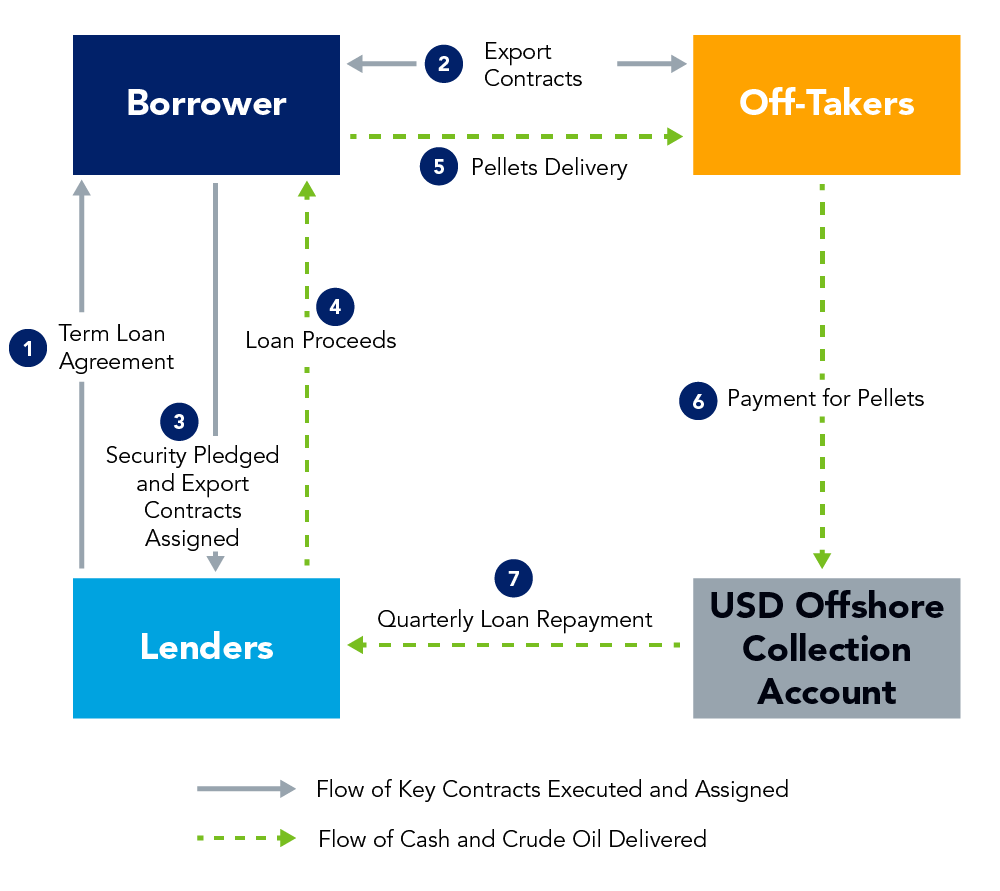Fast reading
- Africa’s largest petrochemical plant in Egypt produces polyethylene pellets used to make plastic bags, pipes and bottles.
- The pellets are sold to international off-takers – intermediaries that have long-term export contracts – which ensure payment is made into a US dollar-denominated offshore account.
- The offshore structure means that the debt is serviced from the customer receipts. It seeks to ensure that Federated Hermes is repaid before any money is set aside to cover the plant’s operational expenses.
Trade finance – short-term loans to facilitate physical cross-border transactions – provides investors with the opportunity to access uncorrelated alpha with limited reliance on traditional return drivers.
The majority of transactions involve third parties to mitigate any payment or supply risks. The case study below outlines the structure of a US$275m senior-secured term loan to the largest integrated petrochemical complex in Africa. The plant, strategically located near the port of Alexandria in Egypt, produces polyethylene pellets which are used in the production of items such as plastic bags, pipes, and bottles.
The government-owned plant – which has an annual production capacity of 400,000 metric tonnes – is vital to the Egyptian economy and accounts for 65% of Egypt’s total polyethylene production1.
Loan structure
Federated Hermes provided the financing as part of a syndicate. The Federated Hermes Trade Finance Strategy – which was launched in 2010 – has longstanding partnerships with leading global banks, which hold meaningful portions of deals on its balance sheet.
The term loan agreement was executed between the plant and the syndicate. The structure of the loan is illustrative of how the Strategy can generate competitive yield, while at the same time mitigating risks, and using top-line cash revenue to repay investors.
The best trade finance deals benefit all the parties involved
The plant produces linear low- and high-density polyethylene pellets which are sold to off-takers – intermediaries that have long-term export contracts with the plant and, upon delivery of the pellets, pay into a US dollar-denominated offshore account. The distributions from this pledged offshore account are controlled by the syndicate of lenders and follow a strict ‘cash waterfall’.
The self-liquidating offshore structure of the loan ensures the debt is serviced from the customer receipts. The structure seeks to ensure that Federated Hermes is repaid before any money is set aside to cover the plant’s operational expenses.
Figure 1: Transaction flowchart

The best trade finance deals benefit all the parties involved. The Egyptian petrochemical plant meets domestic demand for plastic but is also a vital source of hard currency from exports. By exporting the pellets, it gives the country much-needed hard currency such as US dollars.
Robust covenants
The loan has robust financial covenants and is secured on the underlying assets including the petrochemical plant as well as security on the offshore accounts. Property, plant, and equipment and inventory were pledged to lenders and assignment of export contracts give lenders the right to receive payment for the polyethylene pellets delivered to the off-takers.
The plant has an excellent operational track record, operating since 2016 and a strong balance sheet (An EBITDA margin of around 38% and net debt is less than 1.5x.) The weighted average life of the transaction was about 2.75 years2.
Federated Hermes Trade Finance Strategy does not finance bulk shipping – such as mass-produced manufactured goods – and the majority of transactions involve container shipping. As a result, any risks to the transaction are likely to be idiosyncratic rather than macroeconomic.
The Strategy has a highly selective investment process and invests primarily in structured transactions which seek to offer the most attractive risk-adjusted return profile. The portfolio contains a range of loan structures including supply-chain finance, trade loans, corporate term loans, and project finance (such as the Egyptian case study outlined here).
For further information on the Federated Hermes Trade Finance Strategy, please contact Douglas Anderson, Head of Consultant Relations, or Clive Selman, International Head of Sales.








